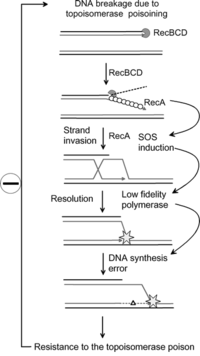SOS反应


SOS反应(SOS response)也称应急反应,是对DNA损伤的整体反应,其中细胞周期被阻止,DNA修复和诱变被诱导。该系统涉及 RecA 蛋白(真核生物中的RAD51)。 RecA 蛋白受单链DNA刺激,参与SOS反应基因阻遏蛋白 (LexA) 的失活,从而诱导反应。它是一种容易出错的修复系统,对在广泛的物种中观察到的 DNA 变化有重大贡献。
详细机理[编辑]
在正常生长过程中,SOS基因受到LexA抑制蛋白二聚体的抑制。在正常情况下,LexA与这些基因的操纵子区域20bp SOS box 结合。由于LexA 蛋白与SOS box 亲和性差异,其中一些SOS基因即使在被中也以一定水平表达。当出现过多的单链DNA在复制叉处时,SOS基因的表达随即被激活,复制叉处的DNA聚合酶解离,复制叉停止。
发现[编辑]
由克罗地亚生物学家 Miroslav Radman[3] 在1975年发现和命名,是指染色体DNA受到严重损伤时细胞做出的应激反应。在这种情况下,多种基因被诱导表达,其中1个拷贝的UmuC和2个拷贝的被截短的UmuD主要组成DNA聚合酶Ⅴ,后者可在DNA模板有切口的区域催化DNA复制。
参见[编辑]
参考资料[编辑]
- ^ Little JW, Mount DW. The SOS regulatory system of Escherichia coli. Cell. May 1982, 29 (1): 11–22. PMID 7049397. doi:10.1016/0092-8674(82)90085-X.
- ^ Michel B. After 30 years of study, the bacterial SOS response still surprises us. PLOS Biology. July 2005, 3 (7): e255. PMC 1174825
 . PMID 16000023. doi:10.1371/journal.pbio.0030255.
. PMID 16000023. doi:10.1371/journal.pbio.0030255. 
- ^ Radman, M. Phenomenology of an inducible mutagenic DNA repair pathway in Escherichia coli: SOS repair hypothesis. Basic Life Sciences. 1975, 5A: 355–367. PMID 1103845.
| 这是一篇与生物学相关的小作品。你可以通过编辑或修订扩充其内容。 |
